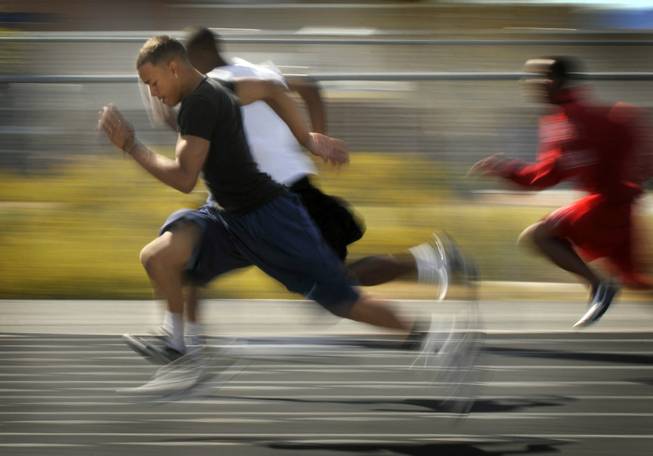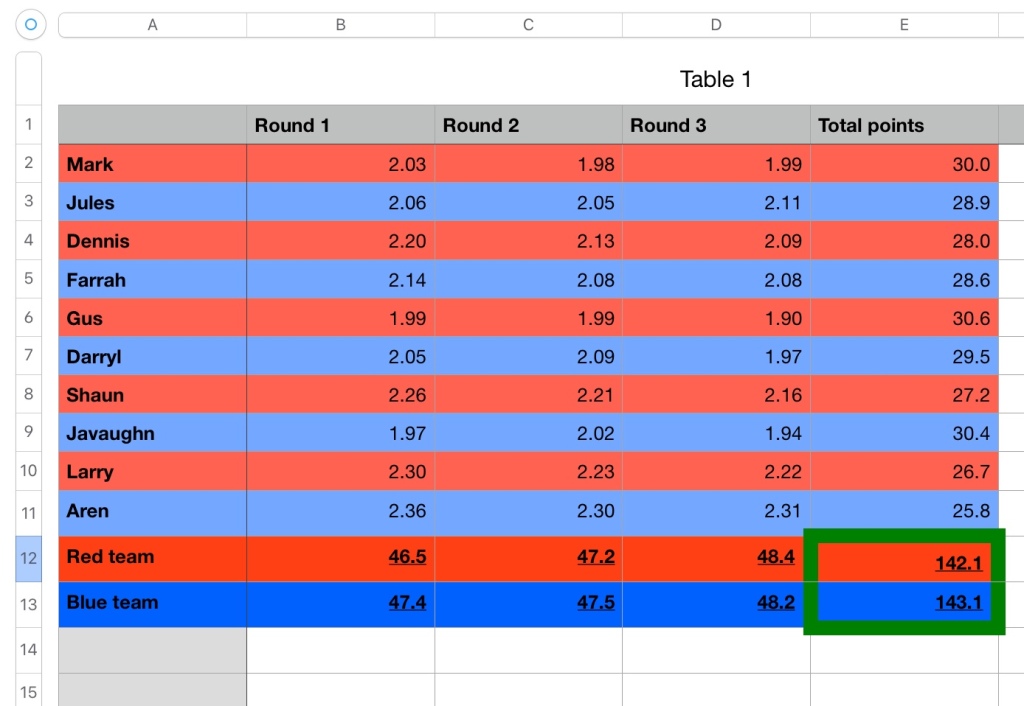
The speed trap is an event where fly sprints (sprints that begin with a running start) are timed electronically and converted into points. The athletes run one after the other like a field event or a 40yd dash at the NFL combine. It is not a race but a series of time trials. To keep the time schedule consistent, an athlete must complete their run within 1 minute of the start of their turn. If they fail to do so, their attempt is not valid. Each team fields five sprinters, and a full game lasts 3 rounds. That means in a single game involving two teams, there are 30 attempts. So the duration would be 30 minutes maximum (more like 20-25).
The length of the speed trap (the fly zone) is always 20m. The run up can be any distance so long as the athlete can complete the attempt within the 1 minute time limit. Though most run ups would be between 20 and 60m. This discipline usually takes place on the 100m straight of a track.

The scoring system would be very simple. The speed achieved in metres per second (m/s) is rounded to the nearest 1/10th of a second. And that is the score
Someone who runs the 20m fly zone in 2.00 seconds is moving at 10 m/s. 10 m/s equals 10.0 points.
As another example, someone who runs a messier number like 2.11 seconds is moving at 9.48 m/s. They would contribute 9.5 points to the team total. A team that can average 10m/s over the course of a game will score 150 points in total. This is the benchmark of a strong speed trap squad.

This idea is influenced by the “feed the cats” coaching style for sprinters. It encourages development of maximum velocity as a sprinter’s main priority. This type of competition is similar to a typical training session under the feed the cats model. Its main strength lies in tapping into the competitive nature of the athletes and boosting participation. Athletes from a wide range of sports are interested in their speed.
Here’s how a speed trap competition at the high school level would look:

The red team had Gus, who was the fastest overall sprinter and scored the most individual points. Yet the blue team managed to win because their team was more balanced and consistent in their flys.
During the training for this discipline it is important to figure out the perfect run up distance before the speed trap. If the run up is too short, the athlete would be too slow at the start of the speed trap. If it is too long, then the athlete will be slowing down inside the speed trap, reducing their score. Faster athletes generally require more distance to reach top speed, but it’s up to the coach of the team to figure out each individual’s optimal run up distance and how it changes as they fatigue. A 20m run up is a good place to start for a novice athlete.

Additional Notes
This event only really works with access to electronic timing. Other methods of timing aren’t very reliable for such a precise measure of speed and hand timing is would make the results meaningless. Video analysis is a little better, but is too time consuming for such a fast paced event. I highly recommend pooling together resources and obtaining a simple electronic system (timing gates, Freelap etc.) if you are planning to organize a team track and field event. It’s useful for training speed athletes anyway.
This discipline pairs well with athletes from track and field. The preparation overlaps with what sprinters and jumpers do in training. The event is pretty low-demand, with each athlete only having to run something like 3x60m with a relaxed acceleration pattern. This is the equivalent of a fun speed training session. As a result, this event can coexist nicely with a track athlete’s typical competition schedule.
It may not be quite as exciting as a traditional sprint race, but the speed trap could offer some unique benefits. There are 20-30 mins of continuous action instead of 10-20 second bursts followed by a long reset. There are no false starts to worry about. It is the purest test of speed and there are opportunities to collect interesting statistics about the players, keep records and make head to head comparisons.
If you have any questions, feel free to contact: projectteamathletics@gmail.com
Upon glancing over all the disciplines, I noticed that the points system for the sprint fly (while being simple to understand) has a narrow band between mediocre and elite. A 2.4 20m fly would net 8.33 points, while a 1.7 fly would net 11.76 points. 125 points for a mediocre team vs 175 points for a record breaking atg team. The other events reliably output 200+ points for dominant performances so I’m wary of the sprints dropping in value comparatively. Savvy coaches would invest less in their sprint squad for more points in endurance, shot put, hurdling etc. On the other hand the lower ceiling is kind of balanced by the higher scores available for average performances. And some events are scored relative to opponents (Hurdle Relay, endurance to an extent, maybe shotput) so there could be an inherent advantage to the events that allow you to get points for absolute performance. Looking at the stats:
| event | sprint fly | endurance | shotput | long jump | high jump | hurdle relay |
| low level/defeat | 125 | 100/75 | 20-50 | 140 | 120 | 90 |
| mid level/close match | 155 | 120/165 | 120-150 | 160 | 155 | 140 |
| elite/sweep | 175 | 190/230 | 210 | 170 | 190 | 200 |
After laying it out in the table, it seems that the sprint flys are pretty balanced in terms of scoring potential, similar to long jump and shot put. So I won’t really change anything except the name (from speed trap to sprint fly). The shot put however is drastically unbalanced after the recent updates… Any coach worth his or her salt would invest heavily in a strong shotput squad because if they’re ever in the situation where a shot put team outmatches them completely they will hemorrhage 30 points off the bat (throw of the round bonus) and 12 points for every meter they lag behind. Average throws of 3m superiority puts the opposition 66 points ahead. I don’t think any of the other events can open a gap like that so easily. The thing is I get the sense that the average athlete is unlikely to throw even 10m. I’m not sure about power athletes like NFL, Rugby, Olympic lifters, but the technique is important too. A skilled thrower (not even elite) could probably get into the 17s. And I’m not convinced a novice (even from a power sport) would do much better than 13m. This contrasts with box jump where almost anyone can come in a score 120 for the team, and being really talented would only put you ahead by 30 points (and elite of the elite only 70 points ahead. A decent shot put beginner seems to be 130 points behind if comparing the elite of the elite). I want more glory for the shot putters, but I don’t want to reduce this hexathlon to a shot put match plus 5 ‘filler’ events. Sure that would be an exaggeration, but I’d prefer to stay as clear of that scenario as possible. Might be worth reducing the squad number to 3 (the – 100 calibration is probably causing the issue). I also need to figure out what the normative standards for shot put are (might be closer than you think after a little training). With a 3person squad, and a 45 point calibration the values still vary a lot with my imagined elite/middle/low tiers: 205/120/55.
Update: I removed the leading throw bonus and it seemed to fix the issues. Now it’s 3 rounds of 3 throwers with 10 bonus points per round for the sector bonus (5 each side). Beginners (avg ~ 10m) would be around 105 points assuming they got half of the sector bonus points (90-120). Proficient putters (avg ~15m) would get around 150 (135-165). Elite putters (avg~ 21m) would earn 204 points (190-220). It’s not perfect (I wish there were more throwers on a squad) but it’s a good start and fits the criteria of short and entertaining. If I really had to add another thrower to the mix, I might be able to use the score manipulation developed in vertical (add or subtract an effort). To provide the right carrots and sticks (incentivize consistency), your best throw is subtracted from the team total (but can still score sector bonuses) so throws 234 contribute to the final score. That means if you throw a banger, it gets ignored (you have to throw at least 2 bangers). This is also imperfect, but it provides the trade off of allowing 4 throwers into the mix.